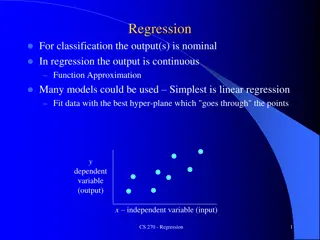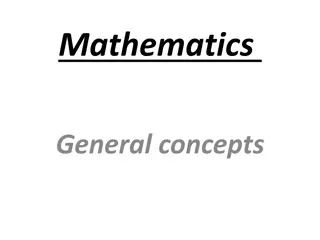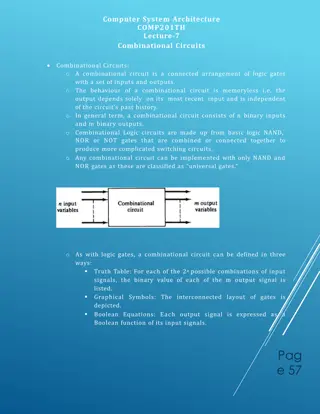Understanding Input and Output Limitations in Op Amps
Explore the various input and output limitations in TI Precision Labs Op Amps as presented by Ian Williams and prepared by Art Kay and Ian Williams. Delve into common mode voltage, voltage swing, data sheet parameters translation, input and output stages, examples of common mode voltage, and potential issues with input and output voltages. Gain insights into troubleshooting issues related to input voltage ranges and common mode voltage. Discover how to identify and rectify problems in op amp configurations to ensure optimal performance.
Download Presentation

Please find below an Image/Link to download the presentation.
The content on the website is provided AS IS for your information and personal use only. It may not be sold, licensed, or shared on other websites without obtaining consent from the author. Download presentation by click this link. If you encounter any issues during the download, it is possible that the publisher has removed the file from their server.
E N D
Presentation Transcript
Input & Output Limitations TIPL 1130 TI Precision Labs Op Amps Presented by Ian Williams Prepared by Art Kay and Ian Williams
Common Mode Voltage VCM (VIN+) + (VIN-) 2 VCM = 10V VIN- - V+ VOS = 30 V OPA140 V- + VIN+ 3
Input and Output Voltage Swing VCM Range 10V - Output Swing VCM V+ OPA140 VOUT V- + 4
Translating the Data Sheet Parameter Conditions Min Typ Max Unit Input Voltage Range Common-Mode Voltage Range VCM Output (V-) 0.1V (V+)-3.5 V Voltage Output VOUT (V-) + 0.2V (V+)-0.2V V RL = 10k , AOL 108dB 5V - -0.1V< VIN < 1.5V V+ 0.2V< VOUT < 4.8V OPA140 V- + -0.1V< VIN < 1.5V 5
Input Stage Output Stage +Vsupply Vgs=0.9V Vds IS1 Q2 VSAT VIN- Q1 Vgs=0.9V VOUT VIN+ VBE Vsat=0.1V Q3 to second stage Q4 Q2 VCE =0.6V Vce Q1 -Vsupply 6
VCM Two Examples VCM = 0V VCM = 5V R1 2k RF 10k R1 2k RF 10k 1 V3 5 VEE 18 VEE 18 - - Vout Vout ++ ++ 1 V3 5 VCC 18 VCC 18 7
Input VCM or Output Voltage Problem? RIN 1k RF 1k V2 -2.5 VOS = 120 V (max) Vout2 171.4mV - Vout1 2.5V - VF2 171.4mV Vos 26.7uV ++ ++ U2 OPA140 -0.1V < VIN < 1.5V U1 OPA140 0.2V < VOUT < 4.8V Output Swing Issue! V3 5 V1 5 Parameter Conditions Min Typ Max Unit An Invalid Op Amp Configuration (Output outside of the linear range) A Valid Op Amp Configuration (Input and Output within the linear range) Input Voltage Range Common-Mode Voltage Range VCM Output (V-) 0.1V (V+)-3.5 V Voltage Output VOUT (V-) + 0.2V (V+)-0.2V V RL = 10k , AOL 108dB 8
Input VCM or Output Voltage Problem? V1 2.5 VOS = 120 V (max) -2.6V < VIN < -1.0V Input Common Mode Range Issue! - VF1 -260.570012mV -2.3V < VOUT < 2.3V ++ U1 OPA140 V2 2.5 What causes the problem here? Conditions Parameter Min Typ Max Unit Input Voltage Range Common-Mode Voltage Range VCM Output (V-) 0.1V (V+)-3.5 V Voltage Output VOUT (V-) + 0.2V (V+)-0.2V V RL = 10k , AOL 108dB 9 9
Input VCM or Output Voltage Problem? -2.6V < VIN < +1.0V Input Common Mode Range Issue! -2.48V < VOUT < 2.48V Parameter Conditions Min Typ Max Unit Input Voltage Range Common-Mode Voltage Range VCM Output (V-) 0.1 (V+)-1.5 V Voltage Output VOUT (V-) + 0.02 (V+) 0.02 V RL = 10k 10
Multiple-Choice Quiz An amplifier s common-mode voltage is __________________. a) The maximum input voltage b) The minimum input voltage c) The average of the voltage applied to the inputs d) The differential input voltage Exceeding the common-mode input range will _______________. a) Cause a nonlinear response b) Cause damage to the device c) Draw excessive current d) Limit the circuit s bandwidth 11
Multiple-Choice Quiz Input and output swing limitations are _______________________. a) Given relative to the power supply voltage b) Guidelines for preventing damage to the devices c) Calculated using Ohm s Law d) Are only valid for DC signals An inverting op amp configuration has a constant common-mode voltage regardless of the input signal. a) True b) False 12
Multiple-Choice Quiz A non-inverting op amp configuration has a constant common-mode voltage regardless of the input signal. a) True b) False A rail-to-rail input amplifier allows common-mode signals _________________. a) Near ground b) Near the positive power supply c) That cover the full range from positive to negative supply d) To be applied without damaging the device 13
Multiple-Choice Quiz What causes the common-mode limitations in amplifiers? a) Overheating semiconductor junctions and ESD diodes b) Internal capacitance and inductance c) Transistor and polysilicon resistor scaling d) Saturation and cutoff transistors in the input stage 14























